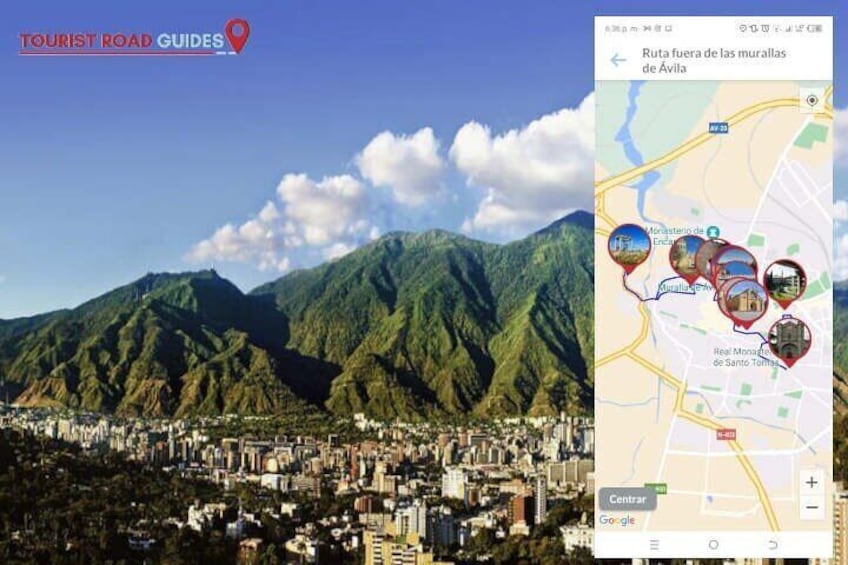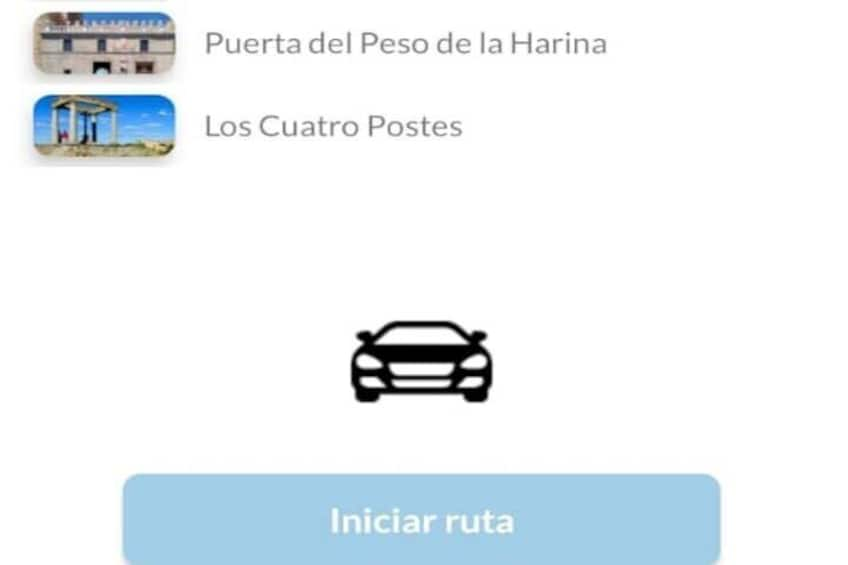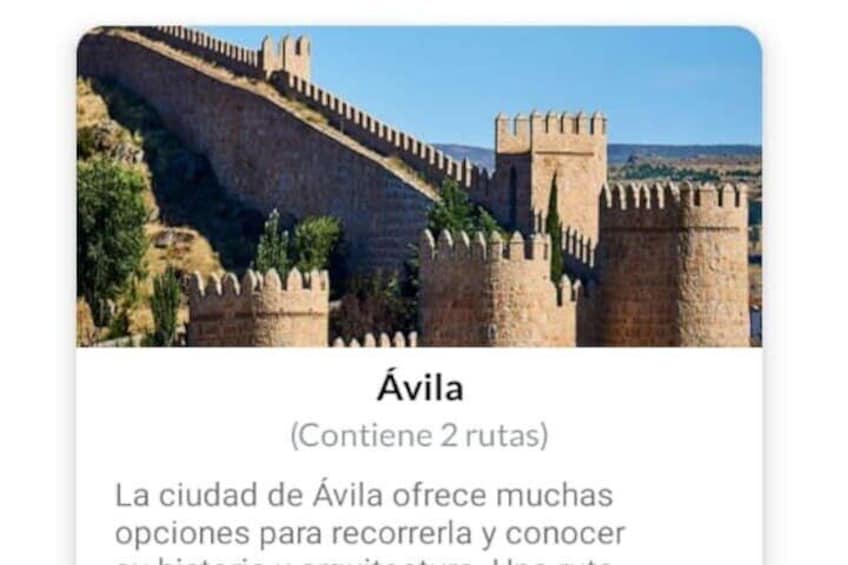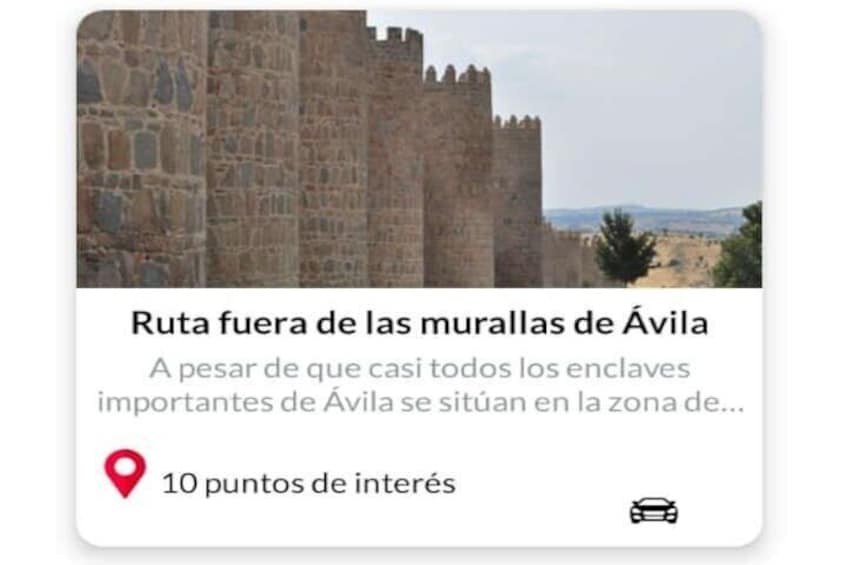List your propertySupportTrips Learn about Expedia Rewards
Learn about Expedia Rewards
Members save 10% or more on over 100,000 hotels worldwide when you’re signed in





APP Self-Guided Routes Ávila with Audioguide
By BARCELONA LANDS
per traveller*
*Get a lower price by selecting multiple travellers
Features
- 12h
- Mobile voucher
- Instant confirmation
Overview
It is a navigation APP with self-guided routes with audio guides through Ávila
Everything you need to know about Avila
Points of interest linked to Google Maps
geolocation
Routes by car in Ávila
Walking routes on the different trails
Access to Web Panel to customise your own route
Access to Panel Web as a repository of travel documents
Audio guides with 6 languages available (Spanish, English.)
Activity location
- Plaza Mercado Chico
- Plaza Mercado Chico
- Avila, Spain
Meeting/Redemption Point
- Ávila
- Ávila, Castile and León, Spain
Check availability
English language complement
- 12h
- English
Language options: English
Starting time: 08:00
Price details
€8.00 x 1 Traveller€8.00
Total
* Select 5 traveller tickets to get our lowest price of €1.60 per traveller
What's included, what's not
- Navigation APP that includes self-guided routes with all the points of interest in Ávila
Know before you book
- Infants and small children can ride in a pram or stroller
- Service animals allowed
- Specialised infant seats are available
- Suitable for all physical fitness levels
- In accordance with EU regulations about consumer rights, activities services are not subject to the right of withdrawal. Supplier cancellation policy will apply.
Activity itinerary
Plaza Mercado Chico
- 30m
- Admission ticket not included
The Plaza del Mercado Chico is the main square of the city of Avila, Spain. It is located in the centre of the city, within the medieval walls. It is a rectangular square with arcades on three of its sides. It is oriented on the NE-SW axis, with the Town Hall on the NE side, and opposite the church of San Juan Bautista, on the side without arcades.
The built sides of the square have three heights: a first with semicircular arches on pillars and two upper ones in which brick predominates.
The square is surrounded by historic buildings, including the Town Hall, the Church of San Juan Bautista, the Palacio de los Verdugo and the Palacio de los Águilas.
Convento de Santa Teresa
- 1h
- Admission ticket not included
The Convent and Museum of Santa Teresa is a historical complex located in the city of Ávila, Spain. The convent was founded in 1562 by Santa Teresa de Jesús, a Carmelite nun who reformed the order of Carmel. The museum was founded in 1957 and houses a collection of objects related to Santa Teresa and the history of the convent.
The convent is located in the centre of Ávila, within the medieval walls. The building is in the Renaissance style and consists of a church, a cloister and a series of cells and rooms. The church is the centrepiece of the convent and has a large Gothic vault. The cloister is an inner courtyard with stone columns and a central fountain.
The museum is located inside the convent and houses a collection of objects related to Santa Teresa and the history of the convent.
Basilica de San Vicente
- 1h
- Admission ticket not included
The church was built in the 12th century and is dedicated to Saints Vicente, Sabina and Cristeta, Christian martyrs from the 4th century. The building has a Latin cross floor plan with three naves, a transept and an apse. The central nave is covered by a barrel vault, while the side naves are covered by groin vaults. The transept is covered by an octagonal dome.
The western façade of the church is the most impressive. It is divided into three sections by pilasters with capitals decorated with plant and animal motifs.
Puerta del Alcazar
- 30m
- Admission ticket not included
The Puerta del Alcázar is one of the access gates to the walled city of Ávila, in Spain. It is located on the west side of the walls, near the Cathedral of Ávila.
The gate was built in the 12th century, during the reign of Alfonso VI of León. It is one of the oldest and best preserved gates in the walls of Ávila.
The door is Romanesque in style and has a horseshoe arch shape. It is flanked by two cylindrical towers 20 metres high. The towers are linked by a vaulted bridge that crosses the moat that surrounds the walls.
The door is decorated with sculptures of animals and biblical characters. At the top of the gate is a statue of a Christian knight.
The Puerta del Alcázar is an important place for the history and culture of Ávila. It is one of the most emblematic gates of the city and is a popular destination for tourists.
Catedral de Avila
- 1h
- Admission ticket not included
The Cathedral of Ávila is a temple of Catholic worship in the Spanish city of Ávila, episcopal seat of the same name, in Castilla y León. It was designed as a temple and fortress, its apse being one of the cubes of the city wall.
It is considered the first Gothic cathedral in Spain, and is one of the best examples of this architectural style in the country.
The cathedral was built in the 12th century, on the remains of a primitive Romanesque building. The construction was carried out in several phases, and was not completed until the 15th century.
Tower of Los Guzmanes
- 1h
- Admission ticket not included
The Torreón de los Guzmanes is a Renaissance building located in the Spanish city of Ávila, Spain. It is one of the most beautiful noble houses in the city and is currently the headquarters of the Provincial Council of Ávila.
The tower was built in the 16th century by order of Garcibáñez de Mújica, on top of another construction that previously belonged to Sancho del Águila. The building is in the Renaissance style and consists of a quadrangular tower, a Renaissance courtyard and a set of rooms.
The tower is the most characteristic part of the building. It is 30 metres high and is crowned by an octagonal turret. The tower façade is decorated with Renaissance motifs, such as columns, medallions and shields.
Palacio de Los Verdugo
- 1h
- Admission ticket not included
The building is Plateresque in style and consists of a Plateresque façade, an arcaded patio and a set of rooms.
The façade is the most characteristic part of the building. It is divided into three sections by pilasters with capitals decorated with Plateresque motifs. In the centre of the façade there is a main window decorated with grotesques.
The porticoed courtyard is the centrepiece of the building. It has a square plan and is surrounded by a gallery of columns. The courtyard is decorated with a central fountain.
Palacio de los Davila
- 1h
- Admission ticket not included
The Dávila Palace, also known as the Abrantes Palace, is a historic building located in the city of Ávila, Spain. It is one of the best examples of medieval architecture in Spain.
The palace was built in the 14th century by order of Pedro Dávila y Zúñiga, first Marqués de las Navas and third Count of Risco. The building is made of the same material as the city wall, granite, and has a defensive structure with towers and barbicans.
The palace is rectangular in plan and has two floors. The main façade is divided into three sections by pilasters. In the centre of the façade there is a main window decorated with Gothic tracery.
Judería de Ávila Antigua
- 1h
- Admission ticket not included
The Jewish quarter of Ávila is located in the centre of the city, within the medieval walls. The area is made up of a maze of narrow, winding streets, which are flanked by one-story stone houses.
The area was founded in the 11th century and was an important centre of Jewish life in Spain. The area was home to a synagogue, a cemetery, and a number of other Jewish institutions.
In 1492, the Jews were expelled from Spain. The synagogue in the Jewish quarter of Ávila was converted into a church and the cemetery was abandoned.
San Vicente Garden
- 1h
- Admission ticket not included
The Garden of San Vicente is a public park located in the Spanish city of Ávila, Castilla y León. It is located in the centre of the city, next to the Basilica of San Vicente.
The garden was created in the 20th century, on the old Roman cemetery of the city. The garden is made up of a set of terraces that descend from the Basilica of San Vicente to the city wall.
The garden is full of trees and plants, and features a number of sculptures and monuments. Among the most outstanding sculptures are the sculptures of saints Vicente, Sabina and Cristeta, which are located on the upper terrace of the garden.
St. Peter's Church
- 1h
- Admission ticket not included
The church was built in the 12th century and is located outside the city walls. The building has a Latin cross plan with three naves and three apses. The central nave is higher than the side naves and is covered with a barrel vault. The side naves are covered with groin vaults.
The main façade of the church is in the Lombard Romanesque style. It is decorated with a set of blind arches, friezes of small arches and a series of sculptures. The main door of the church is decorated with a tympanum carved with a representation of Christ in Majesty.
Real Monasterio de Santa Ana
- 1h
- Admission ticket not included
The Royal Monastery of Santa Ana is a monastery of Cistercian nuns located in the Spanish city of Ávila, capital of the homonymous province, in the autonomous community of Castilla y León. It was founded in 1350 on the initiative of Queen Maria of Portugal, wife of King Pedro I of Castile, and was dedicated to the education of the daughters of the nobility and the royal family.
The monastery was completely rebuilt in the 16th century, following the canons of the Renaissance. The building consists of a church with a single nave with a barrel vault, a three-story cloister, a refectory and a chapter house.
The Four Posts
- 1h
- Admission ticket not included
Los Cuatro Postes is a humilladero located in the city of Ávila, Spain. It is a religious monument built in 1566 that consists of four Doric columns five metres high on which four architraves with the city's coat of arms are supported. In the centre of the square formed by the columns, on a base, stands a granite cross.
The humilladero is located on the left bank of the Adaja River, overlooking the city from the west. It is a popular place for tourists and locals as it offers stunning views of the city.
Location
Activity location
- Plaza Mercado Chico
- Plaza Mercado Chico
- Avila, Spain
Meeting/Redemption Point
- Ávila
- Ávila, Castile and León, Spain
Best Deals on Things to Do
Experience the wonders of the world up close with great deals on things to do near and far. Expedia offers one-of-a-kind activities that allow you to explore Avila your way. Whether you love nature, culture, food or a bit of adventure, we have the perfect activity for you.
Top experiences in Avila
With so many things to do in Avila, planning the perfect day out may seem like a daunting task. Expedia is here to take the hassle out of finding the best attractions, tours and activities in Avila. Families, couples and business travellers can all find the perfect activity in Avila to create life-long memories with the help of Expedia.